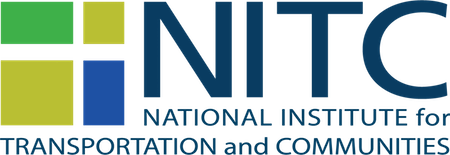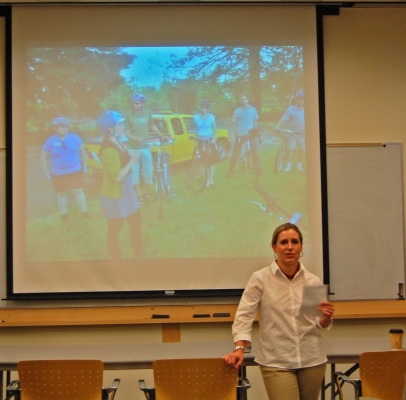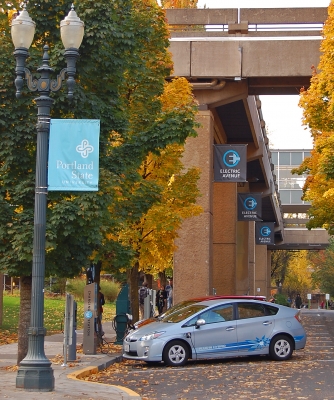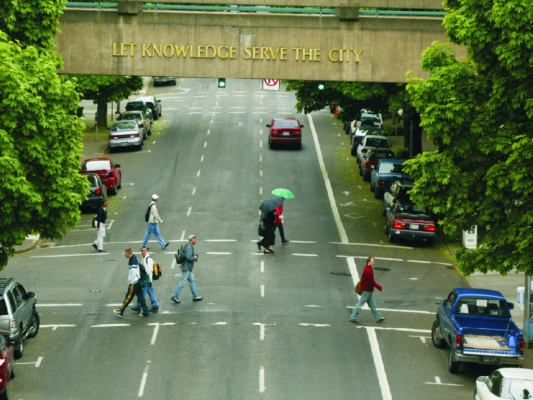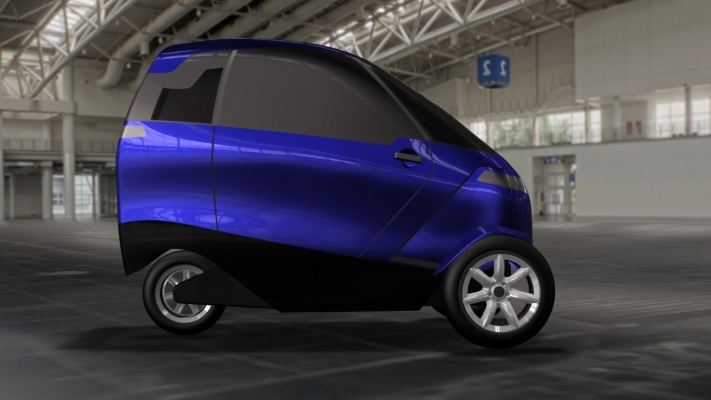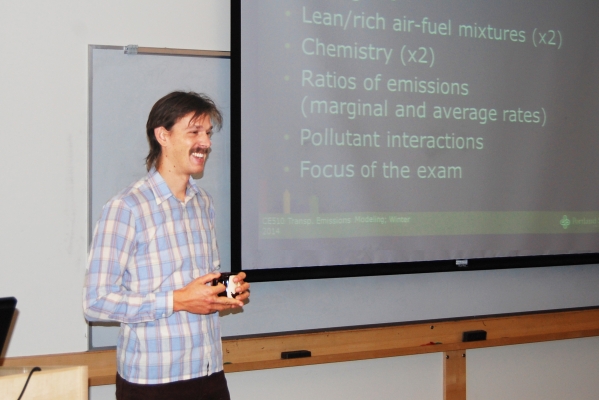With the emergence of electric vehicles (EVs) as an environmentally friendly alternative to the internal combustion engine, OTREC researcher Robert Bass decided to investigate some of the uncharted effects of their growing prevalence.
Bass is interested in measuring and understanding the impacts that electric vehicle charging stations have on their cities’ power distribution systems.
Electric Avenue, located on the Portland State University campus where Bass is an associate professor, is the perfect research opportunity: a row of EV charging stations along Southwest Montgomery Street, between Broadway and Sixth Avenue in downtown Portland, Ore.
Launched in August 2011 as a joint project by Portland General Electric, PSU and the City of Portland, Electric Avenue is intended as a research platform for understanding the impact EVs have within the larger context of the city.
Nonlinear loads such as EV chargers can introduce power quality issues to a city’s electricity distribution system. Bass, with PSU undergraduate student Nicole Zimmerman, set out to measure the power quality effects of EV chargers along Electric Avenue.
Power quality manifests in several ways; for this study, the researchers focused...
Read moreOTREC research from Portland State University has developed a new method of travel demand modeling for pedestrian trips.
Transportation professionals use travel demand modeling to forecast how many people will be using a given portion of the transportation infrastructure. This is typically done using a four-step process, the first step of which relies upon a basic unit known as a transportation analysis zone, or TAZ.
A TAZ is a relatively coarse unit of space that can vary in size depending on planners’ needs; typically it encompasses somewhere around 3,000 residents.
Planners started using TAZs in the 1950s, on mainframe computers with limited capabilities, for guidance in making highway investment decisions. As transportation modeling practice has evolved, computers are capable of processing more data and models are being increasingly relied upon to answer more complex questions.
Despite growing investment in infrastructure that supports active forms of travel, existing modeling tools often poorly represent the nuances of the pedestrian environment. The project’s principal investigator, Kelly Clifton of Portland State University, explores ways to improve upon the modeling tools currently in existence.
... Read moreOTREC researchers and students from the Oregon Institute of Technology have teamed up with Green Lite Motors to test a next-generation hybrid car.
Green Lite Motors, a clean-tech start-up company based in Portland, Ore., has developed a small, three-wheeled, gas-electric hybrid vehicle based on the platform of a Suzuki Burgman scooter.
The vehicle is classed as a motorcycle, and has all the advantages of the smaller vehicle — it doesn’t take up a whole parking space, and it gives off fewer emissions — but it also has an advanced roll-cage design, giving it the safety and comfort of a standard passenger car. It has two wheels in the front, one in the back, and mileage possibilities greater than 100 miles per gallon.
The target market areas for this two-passenger vehicle are urban commute zones, where large numbers of people travel daily from suburban homes to city-based professions.
The tiny hybrid car could change the commuting experience, minimizing gas expenditure and cutting down the time people spend looking for parking.
Green Lite has developed two prototypes.
The first...
Read moreMore attractive streetscapes often lead to an increase in private development, but it can be difficult to visualize future results when they are just potential.
An OTREC Small Starts research project has developed a workflow to create streetscape illustrations for Metro, the regional government for the Portland, Ore. metropolitan area.
Data-driven illustrations that depict planning scenarios are an effective way to communicate to decision makers the results that their investment could bring about. In line with the Oregon Legislature’s greenhouse gas reduction targets, Metro launched the Climate Smart Communities Scenarios Project in 2011.
As part of this project, Metro has developed investment scenarios designed to reduce light vehicle carbon emissions. These scenarios represent potential improvements to urban centers, corridors and employment areas. Improvements such as providing services and shopping near where people live, expanding transit service, managing parking, and providing safer routes for walking and biking can increase transit ridership, support more active travel modes, and thereby reduce pollution.
Principal Investigator Nancy Cheng of the University of Oregon worked with Metro to create a streamlined process for...
Read moreThe Initiative for Bicycle and Pedestrian Innovation hosted its first Webinar Feb. 27, with OTREC researcher Krista Nordback providing an overview of bicycle and pedestrian count programs for the 250-plus registered participants.
The Webinar marks an expansion of IBPI’s professional development offerings, which now also include a sustainable transportation study-abroad program and a wider selection of workshops geared toward transportation professionals and university instructors. Webinar participants were eligible to receive continuing education credits, new this year for IBPI live Webinars and in-person workshops.
While the title of the Webinar, “We are Traffic: Creating Robust Bicycle and Pedestrian Count Programs,” asserts a place for walking and bicycling in traffic discussions, Nordback began with a question: If we really believe that bicycling and walking are modes of traffic, how is that going to change how we measure those modes?
Nordback outlined the Federal Highway Administration’s Traffic Monitoring Guide, published last year. She covered why counting and understanding bicycle and pedestrian...
Read morePortland State University engineering doctoral student Alex Bigazzi has developed a new course aimed at giving transportation engineers experience running emissions models. The course, Transportation Emissions Modeling, is offered through the Department of Civil and Environmental Engineering.
The practical nature of the course sets it apart from the few emissions courses offered at other universities, Bigazzi said. “Those tend to be on the policy side or the environmental side,” he said. “This is unique in trying to help engineers more than policymakers or future policymakers.”
The course fits with both Bigazzi’s own experience and Portland State’s faculty research strength in emissions and modeling. The university already offers an air quality course, but Bigazzi’s offering focuses narrowly on emissions from motor vehicles.
Students spent the first half of the inaugural course learning context for the models, including when they are used and what they can do. “There are federal requirements to do these models for all serious transportation projects,” Bigazzi said. “People need to understand what goes into them and how accurate they can be.”
Because emissions models aren’t as complex...
Read moreThe National Institute for Transportation and Communities, or NITC, program invites proposals for a third round of research, education, and technology transfer projects. The NITC program supports innovations in: livability, incorporating safety and environmental sustainability. This grant is part of the University Transportation Center program, funded by the U.S. Department of Transportation’s Research and Innovative Technology Administration, and is a partnership between Portland State University and the University of Oregon, Oregon Institute of Technology and the University of Utah.
The NITC program will award at least $750,000 in this funding round to research, education and technology transfer projects that support NITC’s theme. Projects should range from $30,000 to $150,000. Projects can focus on research, education, or technology transfer. All projects submitted for this request for proposals (RFP) will undergo peer review. All awards require one-to-one non-federal match in the form of cash or in-kind services from project partners—to include universities, transportation and other public agencies, industry, and nonprofit organizations. Please refer to Section 3 of the linked document below for specific details. Projects awarded under this RFP may start as soon as August 1, 2014 and must be completed by December 31, 2015, including the final report.
Successful research proposals will fit the NITC theme, linking to articulated USDOT priorities:...
Read moreOTREC researcher Miguel Figliozzi details some of the work on an Oregon Department of Transportation project, "Design and Implementation of Pedestrian and Bicycle Specific Data Collection Methods in Oregon," in this video produced by the Federal Highway Administration.
The project reviewed collection methods such as tube counters and loop detectors for accuracy and looked at using count numbers to deterimine average annual pedestrian and bicycle traffic at intersections.
Figliozzi was lead researcher on the project, with Christopher Monsere. Both are associate professors of civil and environmental engineering at Portland State University.
OTREC's Krista Nordback was also involved in the project, as were graduate students Pamela Johnson and Bryan Blanc. More information on the project is at:
http://www.oregon.gov/ODOT/TD/TP_RES/pages/activeprojects.aspx#SPR_754
